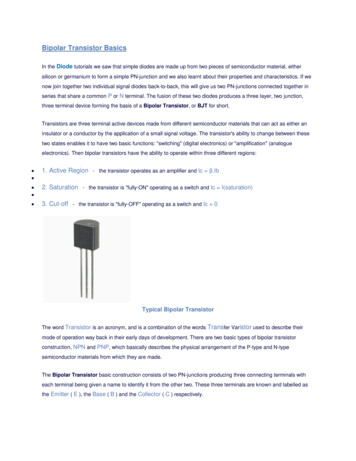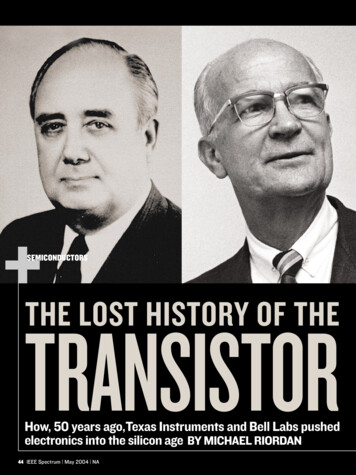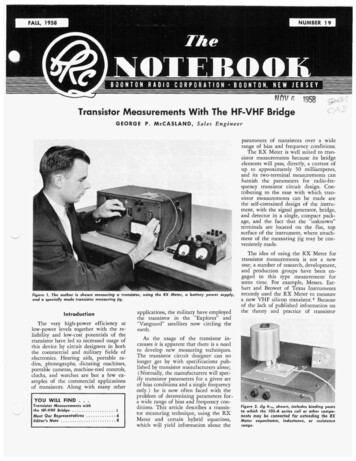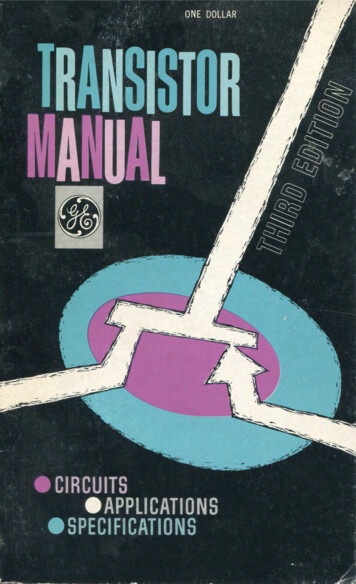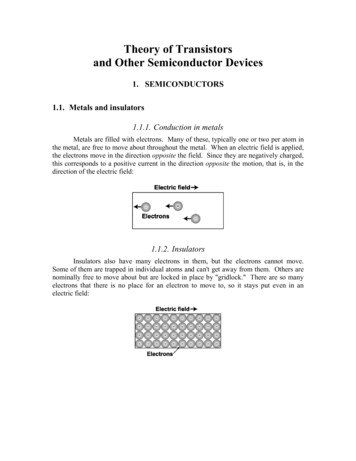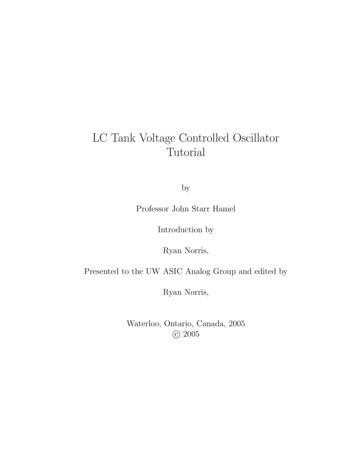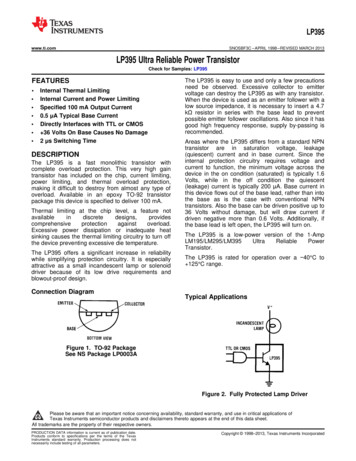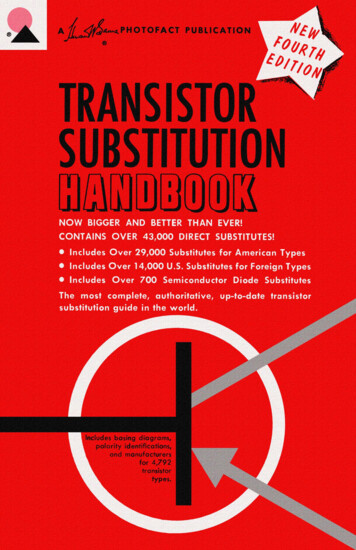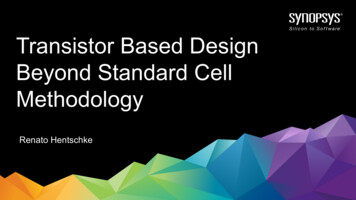
Transcription
Transistor Based DesignBeyond Standard CellMethodologyRenato Hentschke
CONFIDENTIAL INFORMATIONThe information contained in this presentation is the confidential and proprietaryinformation of Synopsys. You are not permitted to disseminate or use any ofthe information provided to you in this presentation outside of Synopsyswithout prior written authorization.IMPORTANT NOTICEIn the event information in this presentation reflects Synopsys’ future plans, such plansare as of the date of this presentation and are subject to change. Synopsys is notobligated to update this presentation or develop the products with the features andfunctionality discussed in this presentation. Additionally, Synopsys’ services and productsmay only be offered and purchased pursuant to an authorized quote and purchase orderor a mutually agreed upon written contract with Synopsys.Synopsys Confidential Information 2020 Synopsys, Inc.2
I work on Physical Design since 1998 with professor Reis19982002MSc20202007PhDIntelSynopsys Confidential InformationSynopsys 2020 Synopsys, Inc.3
I am sure all of his former students would laugh of this slide.For some, Physical Design research was winding down But not for professor ReisTem panoparamangaBrazilian slang for: “there is a lot toresearch about, there is a lot ofwork to be done, etc”In a direct translation that would be:there is fabric for the sleeveThat kept me going Synopsys Confidential Information 2020 Synopsys, Inc.4
Standard Cells are crafted to perfection as an individualBut they don’t really connect perfectly Synopsys Confidential Information 2020 Synopsys, Inc.5
Looking closer, small adjustments can make cells fit betterUnique cells, made for the locationIs it legal?It goes against the standard cell methodology.Synopsys Confidential Information 2020 Synopsys, Inc.6
Agenda1st part: SAT Solvers for Physical Design-My personal experience, lots of existing publicationsOptimal solutions for known Physical Design Problems2nd part: Breaking the standard cell paradigm-Why don’t cells connect very wellOpportunities for applying optimal physical synthesis techniques for small problemsSynopsys Confidential Information 2020 Synopsys, Inc.7
SAT solvers for Physical Design Everybody knows that Physical Design Problems are NP-Complete/NP-Hard. Optimal solutions can be found for small problems. Traditional net-by-net techniques cannot efficiently solve existing designconstraints Need to deal with present and absent objects SAT solvers are way faster than they used to be SAT solvers’ capacity is huge, can deal with 1B variables In my experience, SAT solvers are faster than dedicated code such as exhaustivesearchSynopsys Confidential Information 2020 Synopsys, Inc.8
Given a discrete world, SAT Solvers can model any design rule1Vias cannot form a smiley face shape This can involve up to 8 differentnets, net-by-net algorithms willstruggle to support such rulewithout loss of routability. SAT solvers can easily model thisrule since they consider the all netsat the same time.Synopsys Confidential Information 2020 Synopsys, Inc.9
Given a discrete world, SAT Solvers can model any design rule1Vias cannot form a smiley face shape This can involve up to 8 differentnets, net-by-net algorithms willstruggle to support such rulewithout loss of routability. SAT solvers can easily model thisrule since they consider the all netsat the same time.2Vias can only form a smiley face Trying to make a stronger point thatSAT solvers can model any rule.Synopsys Confidential Information 2020 Synopsys, Inc.10
An even more difficult route problem1234512345vias can onlyappear in asmiley-faceconfiguration5432154321Synopsys Confidential Information 2020 Synopsys, Inc.11
Solution, showing both layers and viasvias can onlyappear in asmiley-faceconfigurationSynopsys Confidential Information 2020 Synopsys, Inc.12
Solution, showing vias onlyIt would be impossibleto route and fill thistestcase with traditional(net by net) routerfollowed by a fillervias can onlyappear in asmiley-faceconfigurationSynopsys Confidential Information 2020 Synopsys, Inc.13
Special features with SAT SolversStandard-cell SynthesisSimultaneous Place & RouteMax SATSolvers can accept arbitrary constraintsEnd of First HalfSynopsys Confidential Information 2020 Synopsys, Inc.14
Standard cell methodology induces local inefficiencies-Design rules beyond cell wallsCell I/O pinsDiffusion breaks and transistor gapsIn place layout improvement (considering neighborhood)Cells cannot be touched because of pre-characterization.Synopsys Confidential Information 2020 Synopsys, Inc.15
Design rules are forced to fit in Standard Cell methodology1. In the lithography world, rules can be of a large sizeToo largeDisregarding cell borders, thesetwo situations would be fine:Not violating theoriginal pattern2. In order to fit the standard cell methodology, rulesneed to be simplified such they fit strictly inside thecell or they can be modelled as a border ruleOk sinceyou knowyourneighborNot violating thefour via ruleBorder rules are always pessimistic becausewe don’t know the cell’s neighbor.Synopsys Confidential Information 2020 Synopsys, Inc.16
Cell I/O pins are generally overdesigned to aid block level P&R1. I/O pins are generally made large in order to ensure enough hit points to the block levelaouta2. After routing, the excessive wiring is left there as an antennaconsuming extra capacitanceout3. It is well known that excessive input cap is bad for your timing.Synopsys Confidential Information 2020 Synopsys, Inc.17
After a block is ready, zooming in to see the problems Zooming in some small window of your block Synopsys Confidential Information 2020 Synopsys, Inc.18
Scenic routing created due to the fixed pin locations1. For example, consider a situation where two instances of a cell are connected:aaoutout2. If they are placed next to each other, they still need to go up to a higher layer to connect:aaoutout3. However, a simple track swap could enable a much cleaner connection.aoutoutaSynopsys Confidential Information 2020 Synopsys, Inc.19
Another category of inefficiencies is with transistor gaps.Synopsys Confidential Information 2020 Synopsys, Inc.20
Standard cells are bordered by transistor gapsSynopsys Confidential Information 2020 Synopsys, Inc.21
Standard cells are bordered by transistor gapsTransistor placement is like dominos There are transistor sharing opportunities across cells since they all share power.PoVDD VDDoVDDaaVDD VDDbNxVSSxVSSyyVSS VSSzVSSSynopsys Confidential Information 2020 Synopsys, Inc.22
Standard cells are bordered by transistor gaps-Some gaps can be eliminated by shifting and flipping transistors-Transistors could even benefit from mixing of transistors of other cellsPVDDooVDD VDDNVSSxxVSSVSSayaVDD VDDbyVSS VSSzGap eliminated – more transistor sharingSynopsys Confidential Information 2020 Synopsys, Inc.23
Cells could have interleaved devices-Some gaps can be eliminated by shifting and flipping transistors-Transistors could even benefit from mixing of transistors of other cellsPVDDooVDD VDDNVSSxxVSSVSSayaVDD VDDJbVDD VDDJyVSS VSSKzVSS VSSKGap eliminated – more transistor sharingSynopsys Confidential Information 2020 Synopsys, Inc.24
Cells could have interleaved devicesSynopsys Confidential Information 2020 Synopsys, Inc.25
One instance Super odSynopsys Confidential Information 2020 Synopsys, Inc.26
One instance Super cellneighborhoodneighborhoodSuper cellneighborhood- One instance cell- Optimized for this neighborhood- Crafted for the cells that are present at this location- Works under timing constraints (let’s talk about this)- Characterized for one usage only (let’s talk again)neighborhoodSynopsys Confidential Information 2020 Synopsys, Inc.27
After all layout is done, we can run local improvements -Sliding window: we can have a very small window thatslides over the design and applies “improvements”over that portion of the layout.Critical/Relevant regions can be prioritized.-We have machines, this is absolutely a highly parallelalgorithm.-SAT/SMT Solvers can find optimal solution to localproblems and provide place&route improvementssubject to constraints from timing analysis.- Timing constraints would be in the form of minand max delay; delay can be measured withsimulator integrated with the solver.Synopsys Confidential Information 2020 Synopsys, Inc.28
Let’s talk about characterization now 1) We already live in a world where lots of things are not fully characterized- Cells are characterized based on some scenarios (for example, typical fanouts) but not all.- Cell neighborhood is poorly considered.- Wires are not pre-characterized (and they are responsible for a large chunk of our delay problems)2) Cells can be recharacterized after transformations; if not acceptable, just discard changes.-Even a cell that is interleaved with other devices (like the one in the picture) can be characterized isolated.Re-characterization does not need to be like traditional std. cell, can be specific to this instance.The neighborhood is completely known and can be consideredThe output load is known and exact3) Timing of a super cell can be measured in context using transistor level analysis.Synopsys Confidential Information 2020 Synopsys, Inc.29
Conclusions – degree of freedom not explored todayLess viasLess wiresLess resistanceLess capacitanceLess antennasLess areaLess masksLess border rules Unique cells, made for the locationIs it legal?Yes, it is legal, and we don’t have tools that explore that!Is it doable? Yes it is doable and it requires researchSynopsys Confidential Information 2020 Synopsys, Inc.30
Transistor Based DesignBeyond Standard CellMethodologyThank you!Renato Hentschkerenato.hentschke@synopsys.com
N VSS x x VSS VSS y y VSS z VSS Gap eliminated -more transistor sharing - Some gaps can be eliminated by shifting and flipping transistors - Transistors could even benefit from mixing of transistors of other cells VDD J VSS K VDD J VSS K

